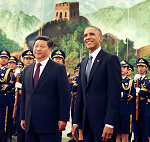The U.S.-China Joint Announcement on Climate Change and Clean Energy Cooperation declared on 11 November 2014 will not only have an impact on the carbon emissions of the U.S. and China, but will also have far reaching implications for India.
“We have been hung out to dry,” one Indian expert said in response to the agreement announced during President Obama’s visit to Beijing.
According to this agreement both the U.S. and China, the world’s two largest polluters, have made specific commitments to lower their CO2 emissions. The U.S. has declared a target of lowering emissions by 26%-28% below its 2005 level by the year 2025. A statement released by the White House says China has promised to make best efforts to reduce its emissions by 28% by 2030 or earlier.[1]
What is even more significant is the Chinese declaration that it intends to reach a peak of its CO2 emissions by about 2030, with the intention to try to peak early, and to increase the non-fossil fuel share of all energy to around 20% by 2030.
This will certainly heighten pressures on India to also declare a set of targets and set a time-table for its carbon emissions to peak. This may not be the best course for India.
The U.S.-China deal is too little too late. However, it is now likely to provide the framework for the global agreement on climate change to be negotiated at the United Nations Climate Change Conference to be held in Paris from 30 November to 11 December 2015.[2]
This means two things. India is being pushed to keep a tight lid on its own carbon emissions. At the same time, slow and low emission-reduction by major polluters will cause an acceleration of climate change. As a tropical region the Indian sub-continent, namely the SAARC countries, will be extremely vulnerable to catastrophic extreme weather events, including lethal heat waves, flash floods and crop failures due to freaky climate patterns.
The latest report of the Inter-Governmental Panel on Climate Change (IPCC) says that global carbon emissions must be reduced by 40%-70% of 2010 levels if we are to prevent a more than 2° rise in global temperature. [3]
According to the Centre for Science and Environment (CSE), India’s leading environmental think tank, the targets announced by the U.S. and China will move the planet closer to a 3°C increase in temperature. This is why a statement issued by CSE describes the agreement as “a self-serving agreement between the world’s two biggest polluters.” [4]
In order to stay within a 2° rise the U.S. alone has to reduce its emissions by about 50%-60% below 1990 levels. The target declared this week means that the U.S. plans to reduce its emissions by only about 15% of 1990 levels.
“This deal puts a sub-standard benchmark for other countries to follow,” according to Chandra Bhushan, deputy director general of CSE. If India were to follow this benchmark, he added, “then we need not do anything till 2040 and beyond. Our per capita emissions in 2030 will be less than 4 tonne CO2e ompared to 12 tonne of the US and China.”
T. Jayaraman, Dean School Of Habitat Studies at the Tata Institute of Social Sciences in Mumbai, is concerned that many Indian bureaucrats working on climate change are in favour of India declaring a peak year for emissions. Instead, says Jayaraman, it is far more important for India to demand a fair share of global carbon space and the freedom to decide how to deploy it over a period of several decades.
Walter Mendoza, vice president of the Indian Network on Ethics and Climate Change (INECC) described the U.S.-China declaration as “a media event, meant to obfuscate the real issues.” For INECC, a network of Indian NGOs concerned about fighting climate change, the biggest issue is that all earlier targets and promises on carbon emissions by the developed nations have not been delivered.[5]
This includes an ill-fated agreement in 1997 which would have seen a reduction in green house gases by 20%. The agreement was scuppered by the Americans as they negotiated it down to 5.2%, says Mendoza. He adds, “Now the U.S. says it will commit to a 26% reduction with 2005 as a baseline! You shift the goalposts and say you’re playing ball!”
At present, the U.S.-China deal has set the tone for global negotiations to take place in a framework of ‘business-as-usual’ – not radical transformation. It remains to be seen whether the Indian government opts to play within this framework, or challenge it. The message from Indian civil society is loud and clear: as Sunita Narain, director, CSE says, “India should push for a principle-based emissions reduction target for all countries. This is the only way we can force the U.S. and China to reduce their emissions which are in line with the planetary limits.”
Rajni Bakshi is the Gandhi Peace Fellow at Gateway House: Indian Council on Global Relations.
This article was exclusively written for Gateway House: Indian Council on Global Relations. You can read more exclusive content here.
For interview requests with the author, or for permission to republish, please contact outreach@gatewayhouse.in.
© Copyright 2014 Gateway House: Indian Council on Global Relations. All rights reserved. Any unauthorized copying or reproduction is strictly prohibited
References:
[1] Office of the President of the United States, U.S.-China Joint Announcement on Climate Change, 12 November 2014, <http://www.whitehouse.gov/the-press-office/2014/11/11/us-china-joint-announcement-climate-change>
[2] Communiqué issued by the Presidency of the Republic of France, France confirmed as host of 2015 Climate Conference, France Diplomatie, 13 November 2014 <http://www.diplomatie.gouv.fr/en/french-foreign-policy-1/sustainable-development-1097/21st-conference-of-the-parties-on/article/france-confirmed-as-host-of-2015 >
[3] Intergovernmental Panel on Climate Change, Fifth Assessment Report (AR 5), 1 November 2014 <http://www.ipcc.ch/>
[4] Madan, Sheeba, ‘World’s two biggest polluters – the US and China – sign a deal on cutting greenhouse gas emissions’, Centre for Science and Environment, 12 November 2014 <http://cseindia.org/content/world%E2%80%99s-two-biggest-polluters-%E2%80%93-us-and-china-%E2%80%93-sign-a-deal-cutting-greenhouse-gas-emissions>
[5] ‘Structure & Governance’, Indian Network on Ethics and Climate Change (INECC), <http://inecc.net/>


